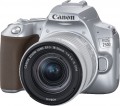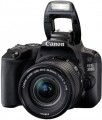DxOMark rating
The result shown by the camera in the DxOMark ranking.
DxOMark is one of the most popular and respected resources for expert camera testing. According to the test results, the camera receives a certain number of points; The more points, the higher the final score.
Light sensitivity (ISO)
The sensitivity range of a digital camera matrix. In digital photography, light sensitivity is expressed in the same ISO units as in film photography; however, unlike film, the light sensitivity of the sensor in a digital camera can be changed, which gives you more options for adjusting shooting parameters. High maximum light sensitivity is important if you have to use a lens with a low aperture (see Aperture), as well as when shooting dimly lit scenes and fast-moving objects; in the latter case, high ISO allows you to use low shutter speeds, which minimizes image blur. However, note that with an increase in the value of the applied ISO, the level of noise in the resulting images also increases.
HDR
Camera support for
HDR.
HDR stands for High Dynamic Range. The main application of this technology is shooting scenes with significant differences in illumination, when there are both very bright and very dark areas in the frame. The features of modern digital photography are such that in the normal shooting mode, only a rather narrow range of brightness can be correctly processed; as a result, with a large difference in illumination, the image contains either too dark or overexposed fragments. HDR avoids this phenomenon: in this mode, the camera takes several shots with different exposure settings, and then glues them together in such a way as to reduce the brightness in bright places and increase in dark places. This allows you to shoot, for example, landscapes against the backdrop of a bright sunset sky, the interiors of dimly lit buildings with bright windows, etc. In addition, HDR can also be used as an artistic technique — to give the picture an unusual colour scheme.
Note that this effect can also be achieved using post-processing in a graphics editor; however, using the camera is much more convenient.
Ultra HD (4K)
The maximum resolution and frame rate of video captured by the camera in
the Ultra HD (4K) standard.
UHD 4K refers to resolutions with a frame size of approximately 4,000 horizontal pixels. Specifically, in cameras for video shooting, resolutions of 3840x2160 and 4096x2160 are most often used. Regarding the frame rate, it is worth noting first of all that a normal (not slow-motion) video is shot at a speed of up to 60 fps, and in this case, the higher the frame rate, the smoother the video will be, the less jerks will be noticeable when moving in the frame. If the frame rate is 100 fps or higher, this usually means that the camera has a slow-motion video mode.
Video scene modes
The number and / or types of scene programs for shooting videos provided in the design of the camera.
Scene programs are a set of presets designed for different shooting situations - for example, in sunlight, on a cloudy day, in a darkened room, etc. Also, this list may include other specific modes - for example, creative tools. In any case, the presence of scene programs facilitates the choice of video shooting parameters, which is very useful for novice users.
File recording formats
File formats in which the camera can record video. Given that the footage is designed to be viewed on an external screen, you should make sure that the playback device (DVD player, media centre, etc.) is able to work with the appropriate formats. At the same time, many camera models themselves can play the role of a player by connecting to a TV via an audio / video output or HDMI (see the corresponding paragraphs of the glossary). And if the video materials are to be viewed on a computer, you should not pay special attention to this parameter at all: problems with format incompatibility in such cases rarely occur, but are usually solved by installing the appropriate codec.
Autofocus modes
Autofocus operating modes provided in the camera design.
— One picture. The main mode of autofocus operation is found in all modern cameras and is used most often. Designed for shooting motionless objects.
— Follower. This mode is used for shooting moving objects, the distance to which is constantly changing: the camera constantly monitors the position of the object, constantly adjusting the optics so that it is in focus. Usually found in middle and upper class cells.
— AI focus. A peculiar combination of the previous two modes is used when a stationary object can start moving at any moment. If the scene is static, autofocus works in the single frame mode, but if the object on which focus is made starts to move, the device switches to tracking autofocus mode. AI mode allows you to almost instantly set the optimal autofocus settings, which is especially useful for sequential shooting. Initially, it was found in expensive models, however, thanks to the development of technology, today it can even be used in inexpensive compacts (see “Camera type”).
— By the face. Autofocus mode that uses a face recognition system and focuses on them. This feature is especially useful for taking pictures of people at a great distance from the camera, when the face is much smaller than the frame size, such as in group shots.
— With a smile. A further development of the face autofocus mode described above, when, in accordance with the nam...e, the system reacts not just to a face, but to a smile. This mode can be combined with the function of automatic shooting at the moment of a smile.
— Animal in the frame. A mode designed primarily for shooting animals, which can be difficult (and often impossible) to make them sit still in the frame. It is usually a variation of the tracking autofocus described above, but specific features of operation may vary depending on the camera model.
This list is not exhaustive, and other specific autofocus modes may be provided in the design of modern cameras.
Viewfinder crop
This setting can be simplistically described as the amount of magnification provided by the viewfinder relative to how the image appears to the naked eye. The features of modern viewfinders are such that most of them have crop values less than 1 — that is, it somewhat reduces the visible “picture”.
In general, the larger this parameter, the larger the objects look in the viewfinder and the easier it is to focus through it.
Communications
-
GPS module. The camera has a built-in GPS satellite navigation module. In digital cameras, the GPS module is used primarily for setting the so-called. geo-tagging to photos: information about specific geographical coordinates of the shooting location is recorded in the service information about each image. However, the matter is not limited to this, and models with this function can have many additional features - from classic navigation to special programs like a database of points of interest with hints based on the current location.
-
WiFi. A wireless standard originally developed for computer networking, but more recently allowing for direct connection between devices. The ways in which Wi-Fi is used in cameras can vary. Thus, the most popular option is to connect to a smartphone, tablet or other similar device for remote control (see below) and / or transfer footage to an external device. Some cameras have built-in software that allows you to directly connect to the Internet through wireless access points and upload photos and videos to popular network services. And in models running Android (see above), specific features depend only on the installed software and may include full access to social networks through client programs (see below) and even web surfing through a browser.
— Bluetooth. A wireless interface used to communicate with various electronic devices. In cameras, Blu
...etooth is most often used to connect to a computer or laptop and transfer footage; In addition, it allows you to use the direct printing function on printers equipped with Bluetooth. The range of Bluetooth communication is up to 10 m, and the devices do not necessarily have to be in direct line of sight to each other.
- NFC chip. NFC (Near-Field Communication) is a wireless communication technology designed to connect various portable devices with each other at a distance of up to several centimeters. In cameras it plays an auxiliary role, designed to facilitate connection with other devices (smartphones, tablets, etc.) using a longer-range standard (Wi-Fi or Bluetooth). Instead of delving into the settings - looking for devices, connecting them manually - just bring the NFC camera to a gadget equipped with the same chip and confirm the connection request.
— Control from a smartphone. The ability to remotely control the camera using a smartphone, tablet or other similar gadget. The connection between the camera and the control device is usually carried out via Wi-Fi (see above), while a special application is used for control, and the gadget’s screen plays the role of a viewfinder. The specific capabilities of such control can be different - releasing the shutter on command, selecting exposure parameters and other shooting settings, focusing by touch, etc. Often, it is also possible to “drain” the footage onto the control device and, through it, to the Internet. Note that for cameras used with mobile phones (see “Camera Type”), this function is not indicated: such a camera is usually mounted directly on the device, and there is no talk of remote control.
